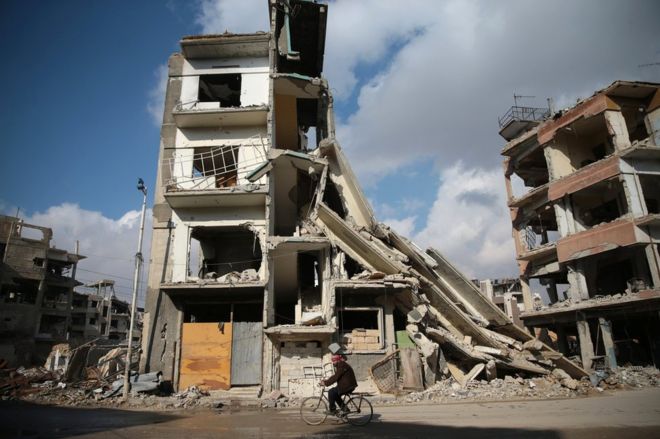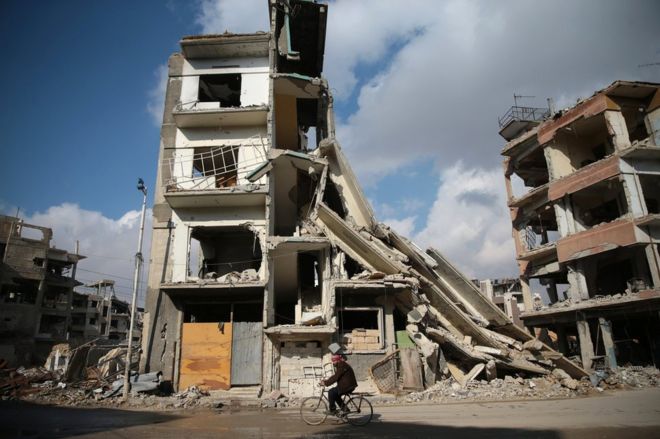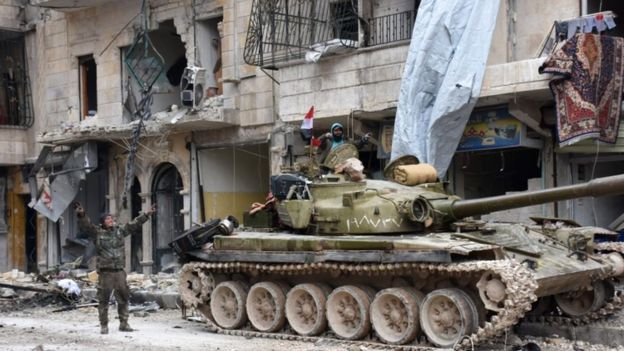

The UN Security Council is to vote on a Russian resolution endorsing the ceasefire agreement in Syria.
The draft text calls for rapid access for the delivery of humanitarian aid throughout Syria.
It also expresses support for a political process to end the conflict, with talks between the government and opposition, brokered by Russia and Turkey, due in Kazakhstan next month.
The ceasefire, which began just over a day ago, has held in most places.
However, some clashes and air strikes were reported and a number of rebel groups told Reuters news agency on Saturday they would consider the truce “null and void” if attacks continued. It was not clear which rebel groups issued the warning.
The ceasefire deal applies across Syria but does not cover certain rebel groups including the jihadists of so-called Islamic State (IS) and Jabhat Fateh al-Sham (JFS), and the Kurdish YPG militia.
- Trump’s Syria conundrum
- Aleppo: Before and after the battle
- Why is there a war in Syria?
- Turkish policy sets new path
The Russian UN resolution comes against a backdrop of deadlock among the veto-wielding members of the Security Council, with Russia supporting Syrian President Bashar al-Assad and the US, UK and France insisting he must step down as part of any deal to end the war.
Russia and Turkey also back opposite sides in the conflict, with Turkey supporting the rebellion against Mr Assad.
Contents
The new kingmakers – Lyse Doucet, BBC chief international correspondent
 Image copyrightAP
Image copyrightAPThis deal was declared before it was done and dusted. Seven groups said to have signed up include Ahrar al-Sham, which Moscow and Damascus have always described as terrorists. Ahrar al-Sham says it has “reservations”. Do they have anything to do with backers like Saudi Arabia and Qatar?
But a new top table has been forged before a new US president enters the scene. Russia is confirmed as the foreign force which matters. Turkey displaced the US as kingmaker on the other side. It has bargaining chips and, most of all, wants to stop the sway of Syrian Kurdish forces, who are US allies.
Many opposition fighters will welcome a pause after their stinging defeat in Aleppo. But they and Turkey still want President Assad to step down. That conflicts with Iran, the other key player, as well as Mr Assad’s own circles. But that’s for the next round in this new great game which could be talks in Astana, in Russia’s orbit.
On Friday, fighting between government and rebel forces was reported in several areas, with the Syrian Observatory for Human Rights, a UK-based monitoring group, saying there had been clashes and air strikes in northern Hama province.
Positions in Wadi Barada near Damascus – held by opposition forces, including JFS, which was known as al-Nusra Front until it formally broke ties with al-Qaeda in July – were also bombarded, it said.
 Image copyrightEPA
Image copyrightEPABut the military denied the report and accused the opposition of aiming to show it was not abiding by the truce.
The UN expressed concern about the fighting in Wadi Barada on Thursday, saying fighters were deliberately targeting and damaging springs used to supply some four million people in the Damascus area with drinking water.
In a joint statement quoted by Reuters, several rebel unnamed groups said on Saturday: “Continued violations by the regime and bombardment and attempts to attack areas under the control of the revolutionary factions will make the agreement null and void.”
Who is included by the truce agreement?
On the one side, Syrian government forces, allied militias and the Russian military.
On the other, a loose alliance of moderate rebel factions that operate under the banner of the Free Syrian Army (FSA), plus several other groups.
 Image copyrightREUTERS
Image copyrightREUTERSThe Russian defence ministry named seven “moderate opposition formations” included in the truce as Faylaq al-Sham, Ahrar al-Sham, Jaysh al-Islam, Thuwwar Ahl al-Sham, Jaysh al-Mujahidin, Jaysh Idlib and Jabhah al-Shamiya.
Ahrar al-Sham, which said it had “reservations” about the deal, and Jaysh al-Islam are Islamist groups that Russia has previously described as terrorist organisations.
Who is not included?
IS and JFS and the groups affiliated to them”, are not part of the agreement, according to the Syrian army.
JFS said on Friday it would continue to fight President Assad, with a spokesman saying the political solution under the truce would “reproduce the criminal regime”.
Members of the group are currently operating as part of a rebel alliance that controls Idlib province.
 Image copyrightAP
Image copyrightAPThe FSA also said the deal did not include the Kurdish Popular Protection Units (YPG).
The militia, which has captured large swathes of north-eastern Syria from IS with US support, is designated a terrorist organisation by Turkey.
Where does the truce apply and on what terms?
It is nominally nationwide, although that really only covers the areas where the sides who have signed up have a presence – western Syria.

Swathes of central and eastern Syria are under IS or Kurdish control.
Under the terms of the deal, talks on a political solution to end the civil war should begin within a month of the start of the truce and would be held in Kazakhstan.
[Source:-BBC]
